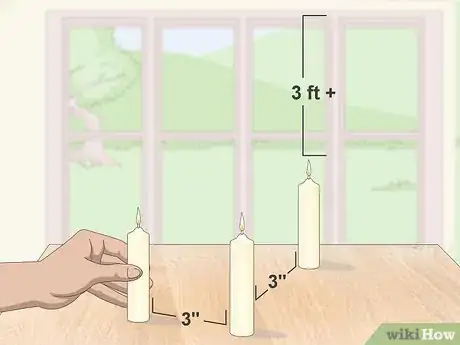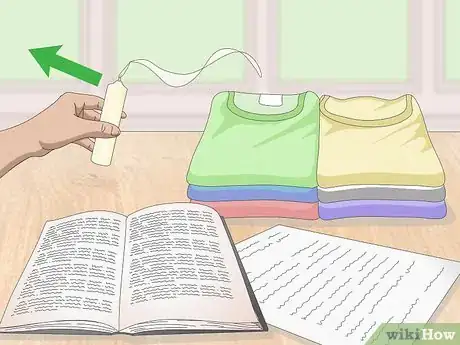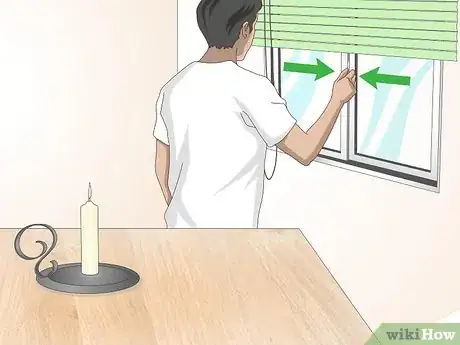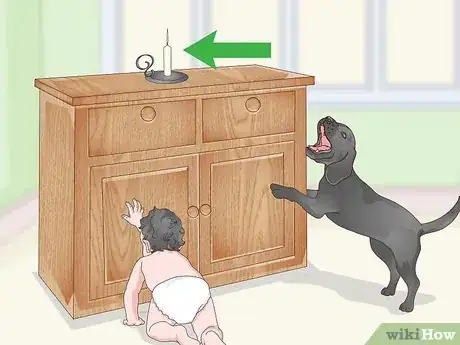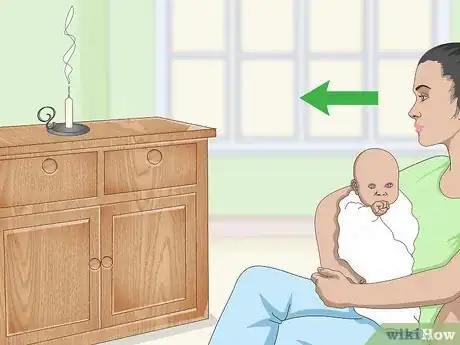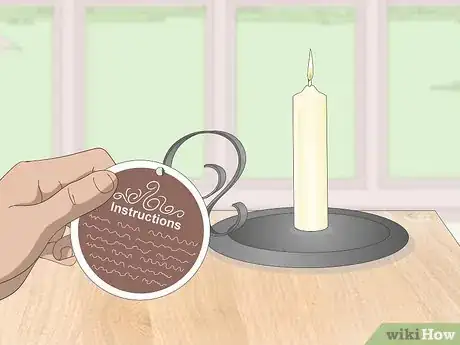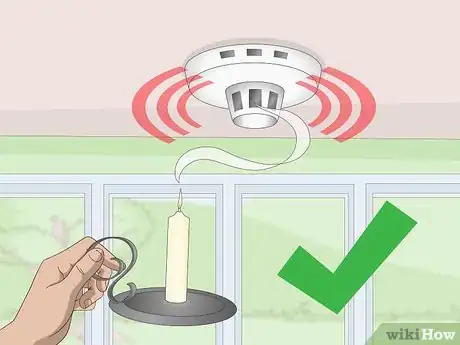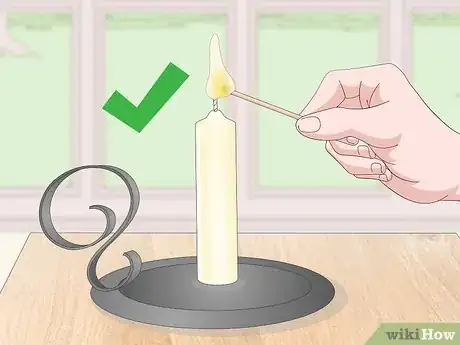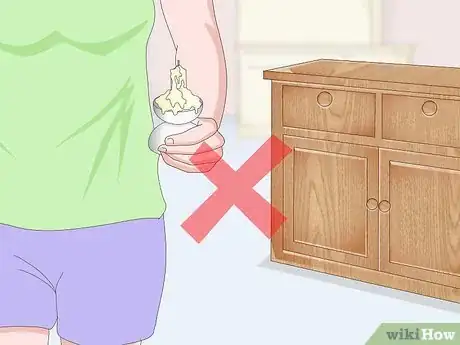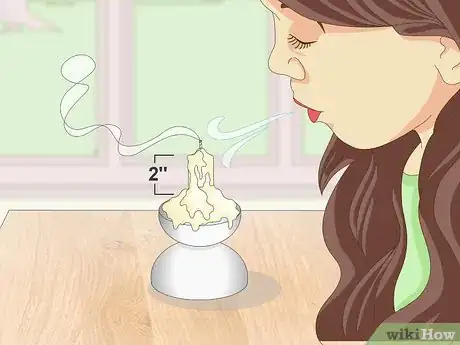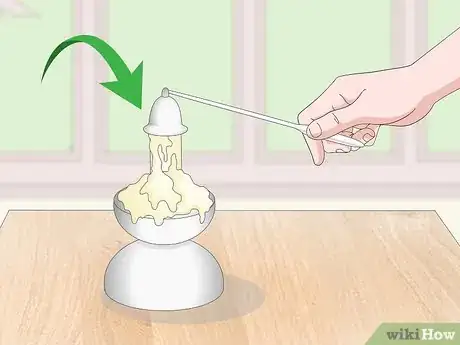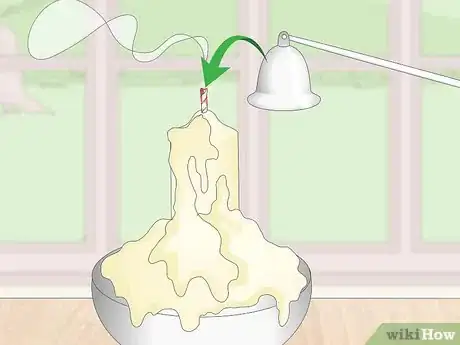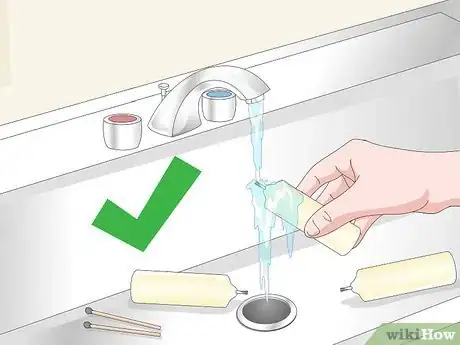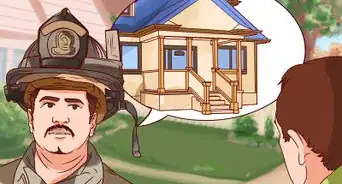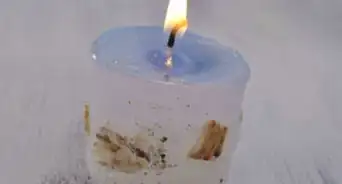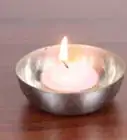This article was co-authored by wikiHow Staff. Our trained team of editors and researchers validate articles for accuracy and comprehensiveness. wikiHow's Content Management Team carefully monitors the work from our editorial staff to ensure that each article is backed by trusted research and meets our high quality standards.
This article has been viewed 124,461 times.
Learn more...
Candles add personality to your decor, establish an element of peace and serenity, and make your home smell great. While there are many benefits to burning candles, proper candle safety is important to prevent accidents or injuries. Candles should never be near anything flammable, and once burning they should never be moved. Make sure you light your candle with care and that you fully extinguish the flame.
Steps
Setting Up
-
1Place the candle in a well ventilated room. There should be at least 3 ft (910 mm) between the candle flame and the surface above it. If burning multiple candles, place them at least 3 in (76 mm) apart from each other. This prevents the candles from creating their own drafts.
-
2Remove your candle from anything flammable. Flammable items include: hair, clothing, decorations, books, paper, carpet, furniture, bedding, or curtains. Tie up any drapes or curtains, and remove any excess fabric.Advertisement
-
3Put your candle in a non-flammable candle holder. Make sure the candle holder you use is designed for the particular candle style and large enough to collect molten wax. Always place your candle on a heat-resistant surface. You can also use a non-flammable hurricane glass.
-
4Check for any open windows or drafts. Do not put your candle under an open window. Drafts or gusts of wind can potentially carry the flame and start a fire. If your candle is near an open window, close the window or move the candle. If your candle is in a drafty spot, relocate your candle somewhere without any drafts.
-
5Place your candle away from the reach of children or pets. Children or pets can accidentally hit the candle and create a fire. Candles, matches, and lighters should always be out of the reach of children or pets.
-
6Keep your candle in sight at all times. You never want to leave a candle unattended. Staying within sight of the candle ensures that your property, your loved ones, and yourself are not in risk.
- It is helpful to inform others in your home when you are burning a candle.
-
7Follow the candle manufacturer's suggestions. Always follow the candle manufacturer's recommendations on proper candle holders, burn times, and extinguishing. Do not exceed manufacturer suggestions.
- Make sure you read all of the directions on your candle before use. Every candle is different, and these are only guidelines for use.
-
8Perform routine fire detector tests. Smoke and fire detectors should be inspected annually to ensure they are working properly. Performing self-maintenance or professional reviews is important to make sure the devices are working properly to prevent any fires.[1]
Lighting Your Candle
-
1Trim your candle's wick to about .25 in (6.4 mm). The wick should remain centered and vertical to ensure it burns correctly. The wax pool should be free of any wick trimmings, matches, or other combustible debris.[2]
-
2Use a match or lighter to light the candle wick. With your index finger and thumb, hold the lit match to the wick of the candle. The wick should ignite in a few seconds of touching the flame. Try tilting the candle slightly to one side to make more room for your fingers and/or the match.
- If you are having trouble lighting the wick, try holding the candle with your longest two fingers (index and middle finger).
- Longer matches and extended-length barbecue lighters also work well to light tricky candles.
- If you are unable to reach the wick with a standard match or lighter, use a piece of spaghetti. Light one end, and use this as your match. Because the spaghetti is easily extinguished and does not burn for long, it can act as a replacement for the lighter or match.
-
3Keep your candle stationary. Never move or touch the candle once the flame is ignited or when the wax is liquefied. The candle holder will become very hot.
-
4Put out the candle when candle burns through. A good rule of thumb is to extinguish the candle when 2 in (51 mm) of wax is left or .5 in (13 mm) of wax remains in the container. This ensures the wick stays vertical and the burn is consistently under control.
- Put out the candle if the flame becomes too high or flickers repeatedly.
Extinguishing the Flame
-
1Put out the flame with a candle snuffer. A candle snuffer safely starves the flame of oxygen and assures the flame goes out without splattering any wax. If you do not own a snuffer, you can use a metal spoon to extinguish the flame.
- Do not use water to put out a candle. Mixing cold water and hot wax can result in wax splatters and possibly burns. The cold water can also shock the glass, resulting in broken candle holders.
- Do not use a knife or sharp object to remove wax drippings. This could scratch, weaken, or break the glass. [3]
-
2Ensure the flame is fully extinguished. Before leaving the room, make sure the ember is not glowing and the candle is fully out. If there is still a bit of red ember burning, use the candle snuffer again.
- Do not touch the candle until it has cooled completely. [4]
-
3Dispose of your candles and flame sources properly. If the wick is less than .25 in (6.4 mm), it is unfit for burning. The candle should be disposed of at this time. When lighting a match, run each match under water before discarding to make sure the flame is entirely extinguished.
- Place all previously lit candles in the sink or metal tray for extra precaution.
Community Q&A
-
QuestionAre candles and candle wax hazardous to my health, and does burning candles without a metal wick poison the air indoors?
 Community AnswerThey can be. Rub a piece of white paper against the wick before you light it for the first time. If the wick leaves a light grey mark like a pencil, it has a lead core. No mark, however, and the candle is lead-free. Most other wicks are made of paper or cotton and are completely safe. To avoid health risks from wax and additives, use unscented candles made of bees wax or soy.
Community AnswerThey can be. Rub a piece of white paper against the wick before you light it for the first time. If the wick leaves a light grey mark like a pencil, it has a lead core. No mark, however, and the candle is lead-free. Most other wicks are made of paper or cotton and are completely safe. To avoid health risks from wax and additives, use unscented candles made of bees wax or soy. -
QuestionWhat can I put under a votive candle in order to place it in a round glass bowl surrounded by glass beads?
 Community AnswerMany votives are sold in a glass or plastic container. If you're buying votives that do not come this way, simply find a small glass container that is large enough for the candle. Place the glass container in the center of the bowl and pour in the glass beads around it. Hint: You can find glass containers of different sizes for votives in the wedding aisle of most craft shops.
Community AnswerMany votives are sold in a glass or plastic container. If you're buying votives that do not come this way, simply find a small glass container that is large enough for the candle. Place the glass container in the center of the bowl and pour in the glass beads around it. Hint: You can find glass containers of different sizes for votives in the wedding aisle of most craft shops. -
QuestionIs it safe to burn large candles or votive candles in a decorative lantern?
 Community AnswerIt depends on the quality of lantern and if it was designed for only decorative purposes. It should specify on the lantern packaging.
Community AnswerIt depends on the quality of lantern and if it was designed for only decorative purposes. It should specify on the lantern packaging.
Warnings
- Candles should never be treated as nightlights, and they should always be monitored.⧼thumbs_response⧽
- It is a major risk to burn candles in the vicinity of oxygen. Oxygen accelerates combustion and can result in larger flames. Be mindful of candle use if there is an oxygen unit in your home.⧼thumbs_response⧽
- If using candles in a power outage, be very careful. Flashlights and other battery powered lights are safer options in the event of an outage.⧼thumbs_response⧽
- On average, there are 25 fires resulting from inappropriate fire uses per day, and 58% of reported home candle fires occur when some combustible material was left or came too close to the candle flame.⧼thumbs_response⧽
- If using a candle during a power outage, do not use candle to look for things in a closet or to fuel equipment (lantern, heater, etc.).[6]⧼thumbs_response⧽
References
- ↑ https://www.vectorsecurity.com/blog/seven-rules-for-candle-safety
- ↑ http://candles.org/fire-safety-candles/
- ↑ http://candles.org/fire-safety-candles/
- ↑ http://candles.org/fire-safety-candles/
- ↑ http://candles.org/fire-safety-candles/
- ↑ http://www.nfpa.org/Public-Education/By-topic/Top-causes-of-fire/Candles
